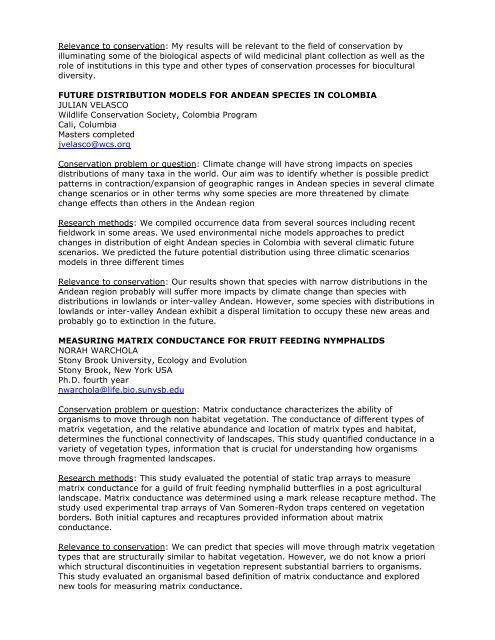Poster Abstracts in Word 29oct - American Museum of Natural History
Poster Abstracts in Word 29oct - American Museum of Natural History
Poster Abstracts in Word 29oct - American Museum of Natural History
You also want an ePaper? Increase the reach of your titles
YUMPU automatically turns print PDFs into web optimized ePapers that Google loves.
Relevance to conservation: My results will be relevant to the field <strong>of</strong> conservation byillum<strong>in</strong>at<strong>in</strong>g some <strong>of</strong> the biological aspects <strong>of</strong> wild medic<strong>in</strong>al plant collection as well as therole <strong>of</strong> <strong>in</strong>stitutions <strong>in</strong> this type and other types <strong>of</strong> conservation processes for bioculturaldiversity.FUTURE DISTRIBUTION MODELS FOR ANDEAN SPECIES IN COLOMBIAJULIAN VELASCOWildlife Conservation Society, Colombia ProgramCali, ColumbiaMasters completedjvelasco@wcs.orgConservation problem or question: Climate change will have strong impacts on speciesdistributions <strong>of</strong> many taxa <strong>in</strong> the world. Our aim was to identify whether is possible predictpatterns <strong>in</strong> contraction/expansion <strong>of</strong> geographic ranges <strong>in</strong> Andean species <strong>in</strong> several climatechange scenarios or <strong>in</strong> other terms why some species are more threatened by climatechange effects than others <strong>in</strong> the Andean regionResearch methods: We compiled occurrence data from several sources <strong>in</strong>clud<strong>in</strong>g recentfieldwork <strong>in</strong> some areas. We used environmental niche models approaches to predictchanges <strong>in</strong> distribution <strong>of</strong> eight Andean species <strong>in</strong> Colombia with several climatic futurescenarios. We predicted the future potential distribution us<strong>in</strong>g three climatic scenariosmodels <strong>in</strong> three different timesRelevance to conservation: Our results shown that species with narrow distributions <strong>in</strong> theAndean region probably will suffer more impacts by climate change than species withdistributions <strong>in</strong> lowlands or <strong>in</strong>ter-valley Andean. However, some species with distributions <strong>in</strong>lowlands or <strong>in</strong>ter-valley Andean exhibit a disperal limitation to occupy these new areas andprobably go to ext<strong>in</strong>ction <strong>in</strong> the future.MEASURING MATRIX CONDUCTANCE FOR FRUIT FEEDING NYMPHALIDSNORAH WARCHOLAStony Brook University, Ecology and EvolutionStony Brook, New York USAPh.D. fourth yearnwarchola@life.bio.sunysb.eduConservation problem or question: Matrix conductance characterizes the ability <strong>of</strong>organisms to move through non habitat vegetation. The conductance <strong>of</strong> different types <strong>of</strong>matrix vegetation, and the relative abundance and location <strong>of</strong> matrix types and habitat,determ<strong>in</strong>es the functional connectivity <strong>of</strong> landscapes. This study quantified conductance <strong>in</strong> avariety <strong>of</strong> vegetation types, <strong>in</strong>formation that is crucial for understand<strong>in</strong>g how organismsmove through fragmented landscapes.Research methods: This study evaluated the potential <strong>of</strong> static trap arrays to measurematrix conductance for a guild <strong>of</strong> fruit feed<strong>in</strong>g nymphalid butterflies <strong>in</strong> a post agriculturallandscape. Matrix conductance was determ<strong>in</strong>ed us<strong>in</strong>g a mark release recapture method. Thestudy used experimental trap arrays <strong>of</strong> Van Someren-Rydon traps centered on vegetationborders. Both <strong>in</strong>itial captures and recaptures provided <strong>in</strong>formation about matrixconductance.Relevance to conservation: We can predict that species will move through matrix vegetationtypes that are structurally similar to habitat vegetation. However, we do not know a prioriwhich structural discont<strong>in</strong>uities <strong>in</strong> vegetation represent substantial barriers to organisms.This study evaluated an organismal based def<strong>in</strong>ition <strong>of</strong> matrix conductance and explorednew tools for measur<strong>in</strong>g matrix conductance.
















